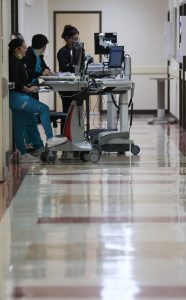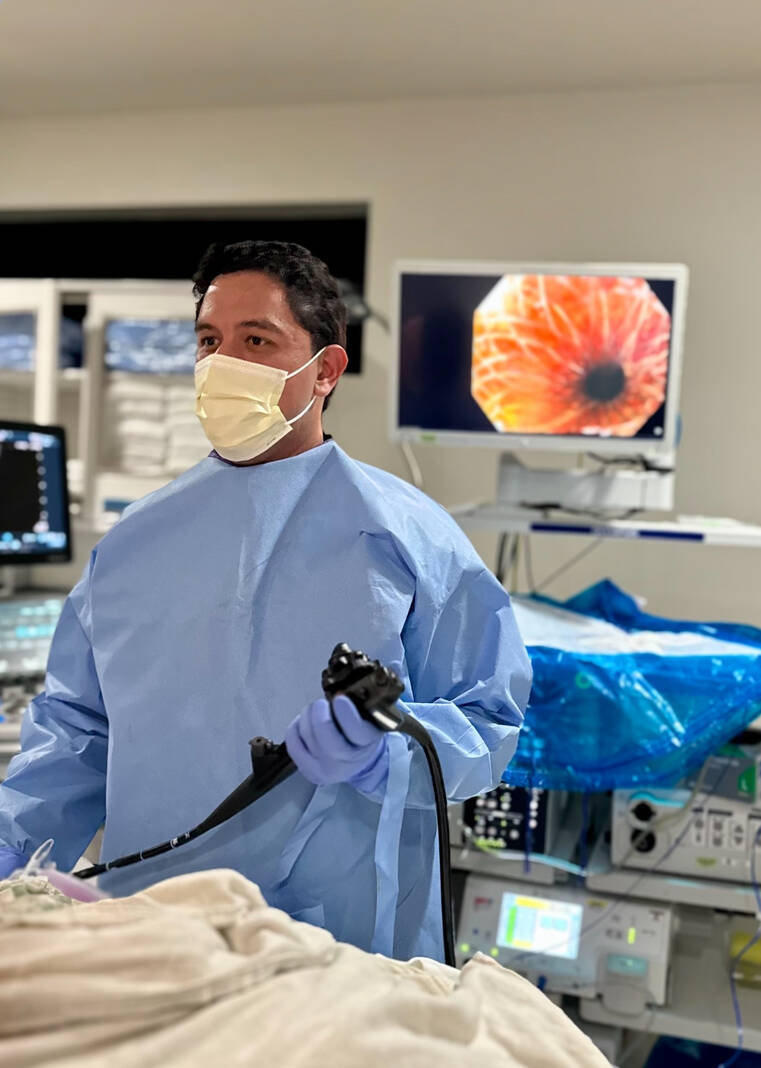|
Only have a minute? Listen instead
Getting your Trinity Audio player ready...
|

Anyone with gallstones can tell you that it’s an excruciating pain which sometimes only surgery to remove the gallbladder will bring relief. But what if you’re already suffering from another condition that prevents you from having surgery?
Now there’s an option available for those who need this kind of care but are non-operable.
Dr. Juan Sanchez, gastroenterologist at DHR Health, performed the first endoscopic ultrasound-guided gallbladder drainage procedure on a female patient in the Rio Grande Valley this summer. It’s a new alternative treatment for acute cholecystitis or inflamed gallbladder.
“Gallbladder inflammation is one of the most common illnesses that we see in the world of general surgery and gastroenterology,” Sanchez said Wednesday, adding that it is often caused by cholesterol stones.
He explained that about 20% of the population has cholesterol stones, which can lead to inflammation and infection of the gallbladder due to stones getting stuck in the duct that drains fluids.
In severe cases it can cause the gallbladder to rupture, leading to more severe issues including sepsis.
Regarding gallstones, Sanchez said that although they’re not often problematic, a patient may have reoccurring issues if the stones create a blockage.
According to Sanchez, common symptoms of acute cholecystitis is pain in the upper abdomen, usually in the right upper abdomen, fever as well as other symptoms including nausea.
“Most of the time when people have acute cholecystitis the treatment is to get their gallbladder removed surgically,” Sanchez said; however, not all patients are able to receive surgery due to other factors.
Because the drainage procedure is not invasive, Sanchez said that it makes it a good alternative for non-operable patients. This includes those who are older, patients struggling with other illnesses such as heart disease or advanced lung disease who would be at risk if undergoing surgery.

“The guidelines that we follow tell us that this (drainage procedure) is really reserved for any patient who is not the best operative candidate,” Sanchez said. “An otherwise healthy 30-year-old person who has no medical problems and would do great with surgery — this is not the best option for that particular patient but it’s a discussion that is always worth having.”
The way it works is that a physician will insert a camera down the esophagus and into the patient’s stomach and use a sonogram probe to identify the gallbladder.
Sanchez explained that due to the gallbladder being infected it is often very large and inflamed with a thick wall due to infection.
The physician will then use a needle to puncture through the stomach and into the gallbladder where they will place a metal stent, creating a connection between the two organs.
The metal stent is left inside the patient for about two to four weeks while the infection is drained out into the stomach and makes its way out through the natural gastrointestinal tract.
He explained that the goal of this procedure is to get rid of the infected fluid and remove any obstruction affecting the gallbladder.
Sanchez added that the procedure length varies depending on the case; however, on average it can take about 30 to 40 minutes if there are no other complications.
The follow-ups also vary case-by-case but will typically include the physician going into a patient’s gallbladder through the metal stent to break up any gallstones. A laser instrument is used here to prevent any future obstructions.
The metal stent is then replaced by a plastic stent, which Sanchez said can stay inside the patient for a longer period of time, to leave an open channel between the stomach and gallbladder as an extra precaution.
He explained that sometimes the stent needs to be replaced or cleaned out depending on how the patient does.
Leaving the stent inside the patient allows him to move medical instruments in and out of the gallbladder in the future if necessary.
The only alternative for treating acute cholecystitis if a patient does not get their gallbladder surgically removed or getting the drainage procedure is for physicians to place a percutaneous cholecystostomy tube, he added.
That procedure consists of a radiologist using an X-ray and inserting a needle through the skin, leaving a tube connecting from the gallbladder to a bag outside the body.
This would mean that a patient would have to adjust to life with a bag.
Sanchez studied at Duke University in North Carolina and brought his expertise back to the Valley where he is from originally, allowing him the opportunity to conduct what DHR Health says was the first drainage procedure done locally.
The female patient who underwent the procedure, which occurred in the first week of July, is said to be doing well.
“I saw her in the clinic about a week or so ago and she was doing wonderfully,” Sanchez said. “… She had no abdominal pain; she was eating well, no nausea, no vomiting. She said that she felt back to how she normally feels, so she was very pleased at how well she was feeling and how quick the progress was.”
You can call (956) 362-8840 for an endoscopy consult or to schedule an appointment.



